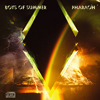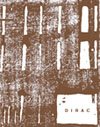- Administrator
- Albums and Singles
 After successful releases on Sedimental and Tilt Recordings Thanasis Kaproulias was invited to the venerable VPRO Radio to perform a piece live, and unsurprisingly it has been released on the Staalplaat label for the rest of the world to hear. The single 47 minute track covers the composer’s sound as it is being refined, capturing elements of other artists such as Francisco Lopez and Bernhard Gunter, but still retaining an identity all his own.
After successful releases on Sedimental and Tilt Recordings Thanasis Kaproulias was invited to the venerable VPRO Radio to perform a piece live, and unsurprisingly it has been released on the Staalplaat label for the rest of the world to hear. The single 47 minute track covers the composer’s sound as it is being refined, capturing elements of other artists such as Francisco Lopez and Bernhard Gunter, but still retaining an identity all his own.
The earliest parts of the performance are most inline with Gunter’s work, consisting of an extremely quiet hiss with microscopic textures that are almost psychoacoustic in their changes. It has a slow build in volume and texture, with shrill tones appearing extremely low in the mix, but still enough to be noticeable. Kaproulias’ penchant for shocking the listener is definitely here, as on his previous work, with an abrupt, violent clattering of field recorded noise crashing in unexpectedly. This appears as a loop, with the subsequent reprises being far less violent and jarring than the first.
The hiss continues under the clattering, which eventually rises into a rushing stream of white noise: a monochrome hiss that initially sounds like simply static, but slowly morphs into a complex composition of chaotic sound. Under the dissonance of the noise, tones that resemble a processed piano appear below the blanket of sound. Occasionally a rhythmic blast of destroyed digital sound comes up to act as a counterpoint to the more inviting tonal elements, but it never lasts for long.
The white noise cuts in and out in Kaproulias’ preferred style, eventually reappearing more as an apocalyptic swarm of locusts that swells into harsh stuttering noise, with the piano-like tones holding on for dear life amidst the end of the world chaos that surrounds it. Eventually it all relents, with the closing minutes mirroring the first moments of near silence, which left me on edge for another moment of jarring noise that never quite happened.
Novi_sad’s style obviously works in a live context, as it does in a more composed studio format. The overall structure is one that is more restrained and minimalist than what was showcased on his other releases, but it never feels overly limited or simplified at all. As usual, the label has packaged this radio performance in a unique way, this time in a digipak style fold-out made of recycled LPs, held together by the ubiquitous center pin. It has a cool appearance to it, and from the sound of other reviews, it’s not going to render the disc unplayable.
samples:
Read More
- Administrator
- Albums and Singles
 The debut release from this synthesiser duo of Andrew Fogarty and Ivan Pawle is a raw but ultimately unsatisfying release which fails to capture the full potential of the group. The basic ingredients are here but they have not come together yet. That being said, this is far from a bad release but based on this EP alone there is not a lot to separate Boys of Summer from the countless other CD-R/tape culture groups out there.
The debut release from this synthesiser duo of Andrew Fogarty and Ivan Pawle is a raw but ultimately unsatisfying release which fails to capture the full potential of the group. The basic ingredients are here but they have not come together yet. That being said, this is far from a bad release but based on this EP alone there is not a lot to separate Boys of Summer from the countless other CD-R/tape culture groups out there.
Like any newborn creature, here Boys of Summer take their first uncertain steps, still covered in the glistening afterbirth that protected them until now. With V they show signs of their capabilities but fail to co- ordinate them properly. “Summertime Greys” at first sounds like a deformed and far lengthier cousin to Throbbing Gristle’s “Industrial Introduction” before launching off into the upper regions of the atmosphere and hovering unnaturally. However, it begins to shudder after a while and falls back down to earth; the piece seems to be far longer than it needs to be. Although, they do rescue it at the very end with a monster jam that sounds like reality rupturing but unfortunately the momentum is lost too early in the piece to salvage it fully.
“Aerial Harassment” finally sees Boys of Summer firing on all cylinders. The queasy dissonance creating a haze of upset noises which show what kind of power is lurking within these men and their machines. It is probably no coincidence that this sudden burst of incredible music features two extra musicians who help expand the range of the group beyond the straightforward but interesting take on jamming with synths that makes up the rest of the EP. Finally, the bonus track on the 2nd edition of this EP, “Zoned out of Life” revisits the ground explored during “Summertime Greys.” This piece is less busy than “Summertime Greys” and works better overall but misses out on the awesome ending of “Greys.”
Having seen these guys live (and based on their second EP, click here for more on that), I know they have more going for them when they get into their stride. The untempered music has its moments of power and V and even at its weakest, it is still a decent exploration of the limits of analogue synths. Yet at the end of the day, V feels more like a warning shot than a fully realised work.
samples:
Read More
- Administrator
- Albums and Singles
 Expanded to a three piece, this second EP from Dublin’s Boys of Summer hits all the spots that V failed to tickle. With a far richer palette of tones at their disposal, the group offer an immensely satisfying journey through the dustier regions of that piece of meat between the ears that calls itself a brain. Like transmissions from another planet, these three pieces are alien sounding and utterly bewitching.
Expanded to a three piece, this second EP from Dublin’s Boys of Summer hits all the spots that V failed to tickle. With a far richer palette of tones at their disposal, the group offer an immensely satisfying journey through the dustier regions of that piece of meat between the ears that calls itself a brain. Like transmissions from another planet, these three pieces are alien sounding and utterly bewitching.
Immediately Pharaoh sounds fuller than its predecessor V. The combination of a smooth but rumbling low end and some of the most beautiful synth tones I have heard this side of Venus make the opening title track sound as regal as the ancient kings it takes its name from. Undulating slowly over the course of the track, the drones coaxed out of the machines by their operators create a hypnotic, vivid tapestry of sound. Unfortunately, at just over 9 minutes, it is way too short.
Luckily there’s plenty more where that came from. Both “Coriolis” and “Beyond” are exceptionally good, the textures created by the various players in both tracks feel like the shimmering expanse of space. “Coriolis” battles with “Pharaoh” for being the highpoint of this EP, its epic scope makes me feel like the insignificant speck of dust I am in the universe but in a totally wonderful way. The humming ambience rolls like waves across the room, expanding as it moves towards me. Taking things down a peg, “Beyond” is less captivating than its counterparts on this CD-R but it is still a beautiful piece and caps off Pharaoh nicely.
Along with Emeralds, Oneohtrix Point Never and their ilk, Boys of Summer are a group who are taking the things I love about bands like Cluster, Coil and the spacier side of Ash Ra Tempel and explore the territory these greats first claimed in the name of music. I am not sure whether Boys of Summer (or indeed any of the new wave of Kosmiche music) have reached the lofty peaks of these pioneers but they certainly show with Pharaoh that they mean to travel far further into the deep space of the synthesiser than many dare to go.
samples:
Read More
- Administrator
- Albums and Singles
 Despite being best known for being half of Cluster, Hans-Joachim Roedelius’ career outside of that group has been even more prolific. Throughout the '80s he released as many albums as I have fingers and most of them are out of print. Thankfully Bureau B are continuing their amazing job of reissuing the Cluster-related back catalogue with this and a Dieter Moebius solo effort out this month. Here Roedelius is in fine form, surpassing himself with this fine selection of melodious pieces. Mixing a very ear-friendly approach to music making with some genuinely thrilling sounds, this album is one of the best things he’s put his name to (even beating all but the most classic releases he’s been associated with).
Despite being best known for being half of Cluster, Hans-Joachim Roedelius’ career outside of that group has been even more prolific. Throughout the '80s he released as many albums as I have fingers and most of them are out of print. Thankfully Bureau B are continuing their amazing job of reissuing the Cluster-related back catalogue with this and a Dieter Moebius solo effort out this month. Here Roedelius is in fine form, surpassing himself with this fine selection of melodious pieces. Mixing a very ear-friendly approach to music making with some genuinely thrilling sounds, this album is one of the best things he’s put his name to (even beating all but the most classic releases he’s been associated with).
Opening the album, the title piece calls to mind the softer parts of Harmonia’s Deluxe or the works of Brian Eno (either in collaboration with Cluster or not). The beautiful synthesiser rhythm has a dreamy quality which plays well against the second synthesiser part that explores the full tonal range of the piece. The quivering high notes are like mechanical birdsong in a clockwork forest. “Veilchenwurzein” immediately follows along the same path, interlocking melodies and soaring lead lines creating a beautiful and rich sonic landscape. Roedelius could easily pursue an entire album in this vein and keep me very happy but, forever restless in his creativity, Wenn der Südwind weht is an even better album for its variety.
Roedelius pushes his music outside the territory he and Moebius usually occupy with Cluster. On “Freudentanz” the music truly lives up the title (“joy-dance” being my approximate translation of the title) with more than a little Chuck Berry breaking into the normally unearthly electronic body of Roedelius’ work. In a complete about-turn in terms of mood, “Saumpfad” takes the more ambient approach explored by Roedelius in his previous solo albums and takes it to a darker, more intimidating place. The deep pulse at the centre of the piece has an evil heartbeat character to it, a murmur in the cosmic electrocardiogram.
With Wenn der Südwind weht Roedelius has simultaneously consolidated his previous approaches to his music and opened a number of new paths for him to investigate in later years. Each of the tracks is a miniature masterpiece, capturing both the time the music was created in and the endless possibilities of the future. Like Cluster’s final albums prior to going on hiatus, Wenn der Südwind weht is a document of unbridled exploration that resonates as loudly today as ever.
samples:
Read More
- Administrator
- Albums and Singles
 The solo project of Sami Hynninen is by turns slightly creepy, unexpectedly profound, and quite hilarious as his unwieldy guitar-based songs and wild imagery reference necrophilia, rainbows, sado-masochism, bunnies and fart sniffing.
The solo project of Sami Hynninen is by turns slightly creepy, unexpectedly profound, and quite hilarious as his unwieldy guitar-based songs and wild imagery reference necrophilia, rainbows, sado-masochism, bunnies and fart sniffing.Cobra records claim that Opium Warlords is an identity secret with this disc arriving from persons unknown. But many other sources seem to know that it comes from one person: Sami Albert Hynninen, known for his work with The Puritan, Reverend Bizarre, Armanenschaft, Spiritus Mortis, and more. The release is full of the contradictions which come from naming your "group" Opium Warlords and residing, at least symbolically, in the territory of death metal or Satanic rock. Despite the clichés, Live at Colonia Dignidad offers a few surprises. For example, the splendidly named “Suck My Spear, Servant of Satan” turns out to be an unexpectedly relaxing listen rather than an ode to some darkly stylized oral sex ritual. The piece is almost pseudo-medieval in tone, as if Tortoise had been inspired by a dub version of a Wishbone Ash instrumental.
Much of the album is ponderously paced. This slowness is doubtless meant to convey threat but also suggests a lack of technique. At times the music does indeed (as claimed on the Opium Warlords MySpace page) sound like "a bad Bolivian Metal band practicing a riff" but some patches stir up an odd sense of humans wallowing in mud and leaves a la Samuel Beckett’s story How It Is. The vision is of depressed or wretched ones refusing to stop crawling through crap, even enjoying it. At such times, Opium Warlords’ contemplative, brooding tempo is nicely out of sync with the dizzy but superficial haste of modern life.
Photos on the website show Hynninen from the back, stripped to the waist and wearing a hip-hugging bullet belt and boots. He is slouching near a bare tree and in his right hand is a hardback book which, given its heft, looks rather paradoxically like Elizabeth David’s English Bread and Yeast Cookery. Obviously that’s not the case, but maybe it is a reasonable signal of the dilemmas inherent in approaching this music. For in the year 2010, it is hard to imagine that devil-worship exists as anything more than sexual fetish, nostalgic symbolism or a stance to annoy self-appointed moralists. At the same time, while it is hard to swallow this album with a straight face it is easy to grasp that Hynninen fully realizes both the humor and the paradoxes. On some pieces, such as “Meet Me at The Iron Place” and particular on the urine erotica song "Let it Pour, Let It Pour" he enunciates his words to good effect. Elsewhere his cartoon-constipated grunt voice obscures lyrics which are as likely to divide opinion as Pynchon’s infamous excrement swallowing scene in Gravity’s Rainbow. Luckily, samples of these (images of raw sex, painful depression, fluffy animals and forest mythology) are in an accompanying booklet along with childlike sketches, occult references and an ad for Zyprexa tablets with the requisite (devilish) barcodes.
The repetitive medium-paced instrumental “Feel The Strength” is (at three minutes) much shorter than most of the songs, a few of which could have been trimmed. The sole fast track is “Support the Satanic Youth.” This lasts just five seconds but for some reason I found it genuinely uncomfortable. On the one hand, it’s a laughable, throwaway, incomprehensible speed rant, but that had me half-wondering if the humor is not a double-bluff similar to the circular logic of those Christians who claim that the best trick the devil ever pulled was to convince us that he doesn’t exist. I conclude that, as in the spheres of politics and religion, reality in the world of metal is whatever the participants decide it to be; a handy device.
For all its lumpy predictability, Live at Colonia Dignidad is also heavy and uncompromising in a good way. During some of the slow rambling guitar work, away from the ham-fisted lyrical signifiers, Hynninen stumbles upon mystery. His choice of the name Opium Warlords is terrific, and befitting of the complex and hilarious nature of human “evil.” The name conjures such hidden or murky histories of war and trade as those of the British in China, the French in Vietnam, the heroin labs of Marseille, the Golden Route, and the US involvement with international crime syndicates. It evokes excellent stories such as the release of Lucky Luciano and the role of the Mafia in assisting the Allies in opening a second front in WWII. It reminds of the marvelous saga of Fidel Castro’s exploding cigar, and the less amusing legend of Ollie North’s covert exploits in Colombia and Iran. It hints at recent fables of CIA tolerance for Afghan opium production and export during the US backed Afghanistan war against Russia. But amidst all these, the alleged payment of $43 million to the Taliban government for crushing opium production, just months before the US invasion of Afghanistan with the support of the Afghan opium warlords, may be the most incredible tale of all.*
*Ed Felien: The Big Payoff
samples:
Read More
- Administrator
- Albums and Singles
 First released in 1984, this album represents Dieter Moebius’ first foray into solo composition after over a decade playing with some of the giants of the German avant garde in the 1970s. There’s always a danger with serial collaborators that they cannot reach the same heights as when they are supported by other artists but Moebius proved that he could hold his own with this gorgeous little album. Although it sounds exactly as expected based on his previous collaborations, it is far from retreading old ground as you can get. Each of the pieces are packed with crystalline melodies set to precise beats and rhythms, all finely crafted and comforting in their familiarity.
First released in 1984, this album represents Dieter Moebius’ first foray into solo composition after over a decade playing with some of the giants of the German avant garde in the 1970s. There’s always a danger with serial collaborators that they cannot reach the same heights as when they are supported by other artists but Moebius proved that he could hold his own with this gorgeous little album. Although it sounds exactly as expected based on his previous collaborations, it is far from retreading old ground as you can get. Each of the pieces are packed with crystalline melodies set to precise beats and rhythms, all finely crafted and comforting in their familiarity.
Compared to Hans-Joachim Roedelius’ output from around the same time, Tonspuren is not much of a jump from Moebius and Roedelius’ previous work as Cluster. During the '80s, both artists took time out from Cluster to forge solo careers that, although meandering, never strayed too far from the sounds and compositions developed through their collaboration together. The first few pieces on Tonspuren could easily sit on Cluster’s Curiosum without sounding out of place. “Contramio” is one of those sweet, melodic pieces that define the Cluster sound as much as their experiments in ambient electronic drift do. It is evident from listening to this and Roedelius’ own solo work that Moebius was responsible for much of Cluster’s more sugary moments.
However, this is not to say that Tonspuren is just more of the same from Moebius. On “Etwas,” Moebius has incorporated some of the more interesting ideas from his sessions with Mani Neumeier and Conny Plank on Zero Set; skittering noises jump across the beats in a dizzying way. The heavy beat of “B 36” combined with the kind of synth lines that are more air raid siren than anything else evokes the tension of the Cold War with its threat of nuclear war, the B 36 being a prime contender for carrying such a devastating payload. The fear that filters through the piece is palpable even in the absence of any real contextual information (according to the Internet B36 could also be a soccer team).
Even taking the Cluster “template” (if such a thing could be said to exist), Moebius challenges himself to create new textures from familiar arrangements. “Immerhin” clocks in at well under three minutes but contains enough variation to make it seem like a much grander piece of music. On the surface it is a facile and easily digestible piece but the grain in the sounds used make it far more interesting than a superficial listening would suggest. Deep listening is usually associated with the dronier side of minimalism but here Moebius shows that the same approaches should be applied to more “active” forms of music.
While not the pinnacle of his lengthy back catalogue, Tonspuren represents a point in Moebius’ career where he finds himself at a point where he needs breathing space. Not as prolific as his partner in Cluster, he still had been working pretty much constantly for the last decade on a lot of challenging and rewarding music. Therefore it is no surprise that there is not a huge leap between his earlier efforts and the music found here. As I argue above, familiarity does not always imply stagnation and Moebius shows that it is possible to take something that could almost be described as formulaic and reveal details in music that were invisible before.
samples:
Read More
- Administrator
- Albums and Singles

artist Mouthus/Bulbs
title: split
catalog #: IMPREC255
release date: Feb 16, 2010
format: LP
Limited edition of 500 numbered copies. Screenprinted at Monoroid.
Bulbs features William Sabiston formerly of Axolotl.
Mouthus: Drum and guitar explosion through tape manipulation and a total synth bath. Collided
through a number of recording sessions and strings of modulation to elevate the
particle riffage to a heightened state of platectonic rock.
Bulbs: Like tuning your radio slowly between far off New Age stations in the most
serene way possible. The marriage of muted melodies existing below feedback skwerls
and electronic swerls. Transmissions from a better place.
Read More

It is nearly impossible to find any concrete information about this shadowy psychedelic collective, aside from the fact that they first surfaced in Alaska about fourteen years ago and that they are now active in Oakland as both Nommo Ogo and Katabik Soundsystem. How they managed to maintain such a low profile is still more of a mystery, as this collection contains some of the most otherworldly and unique music currently being made.
- Administrator
- Albums and Singles
 Hailing from Vienna, this relatively new trio has refined their approach to a post-rock and ambient influenced sound that, unlike many of their contemporaries, focuses more on the live collaboration to develop their sound, and not as much on DSP processing and effects laden sound.
Hailing from Vienna, this relatively new trio has refined their approach to a post-rock and ambient influenced sound that, unlike many of their contemporaries, focuses more on the live collaboration to develop their sound, and not as much on DSP processing and effects laden sound.
Spread across four long tracks, the trio has an intentional sense of isolation injected within the sound. Recorded over a week in the basement of member Florian Kindlinger’s parents’ house, and then edited in a small hut in the Austrian mountains, there is a sense of being alone amidst the lush ambience. The opening "This Is Your 4AM Wake-Up Call" begins with slow ringing reverse textures, a low rhythmic pulse and an odd clicking sound finally appear. The track builds in complexity, adding subtle layers of sound that, on their own seem rather sparse, but taken together, along with guitar and fragments of voice, sound like a deconstructed take on shoegaze ambient, complex yet beautiful and inviting.
Heavily effected string and sparse ambient sounds introduce "Augarten," and a distant kickdrum acts like a heartbeat in the extremely intimate recording. Compared to the opener, the heavily tremolo’ed strings that stretch for infinity stay the primary focus, with only the occasionally plucked string, or the sound of movement picked up by an ambient microphone. Because of this extremely simple structure, it’s more like being in the room as the tracks were being laid down as opposed to a polished studio (or live) recording.
"Bantu" brings back more of the processing and effects, with the metallic pings and rattles and subtle guitar pushing it into improvisation-land, with field recordings and wind chimes fleshing out the sound. As the track closes, a lush organ and digital textures push the volume up to full on power ambience: heavy and room-filling, but never oppressive or harsh. The closing "A Rest in Tension" lives up to its name: it mirrors the textures of the opening track, but keeps the dense heaviness of "Bantu" on and on, even above recordings of conversations and long, drawn-out sounds before ending on a sparse note of a clicking metronome and distant bells.
As previously stated, there’s a constant sense of isolation and intimacy here: even though field recordings occasionally put the sound in a wider context, there is still the feeling of being in a room with these guys as its being recorded, in an entirely different world. The shoegaze and ambient elements pervade, but never feel like a crutch to be leaned on. Too often bands will simply pile on the effects to create a lush, heavy feeling, but here it feels truly warm, and truly different.
samples:
Read More
- Administrator
- Albums and Singles
 As Imminent Starvation, Olivier Moreau famously trashed his mixing board after the completion of 1999’s Nord and gave the pieces out in a special collector’s edition. Now, after spending time with Synapscape and putting out a few 7” singles, he has returned with a new album that shows he hasn’t missed a step in his near decade hiatus.
As Imminent Starvation, Olivier Moreau famously trashed his mixing board after the completion of 1999’s Nord and gave the pieces out in a special collector’s edition. Now, after spending time with Synapscape and putting out a few 7” singles, he has returned with a new album that shows he hasn’t missed a step in his near decade hiatus.
I always considered Moreau’s work for the label as the definitive "Ant-Zen" sound: rapid fire overdriven analog drum machines, raw synths, mutilated samples and a general sense of post industrial malaise. Cask Strength doesn’t step too far away from this formula, because it’s still a grinding cacophony of noise and beats, and I don’t think any of his fans would have wanted to see drastic change. There does seem to be an increased sense of experimentation and concessions to the pathetically named IDM sound here though, proving it’s not all just 909s and fuzzboxes.
The influence is apparent from the opening "Seracs" with its polyrhythmic plastic beats that are completely chaotic, but obviously well sequenced, with deep raw synth line that’s a bad trip version of acid techno. The odd juxtaposition of a stuttering voice, which is reminiscent of how Autechre has treated vocals the few times snippets were present, and a rather unabashed synth pop melody is a unique one covering both the harsh aggressive sound, yet concedes a bit of beauty amidst the ugly.
"Teskede" is cut from a similar cloth, with hardcore rattling beats and synth leads that sound more like radio static than anything else, but with some more warm, gentle synth work buried under the grime. "Rubbs" also does this combination, but keeps the jagged rhythms more in check, and allowing the synths to be the track’s focus. Here it’s pretty clear that if one were to remove the rhythms, there would be a rather pretty ambient track hiding under them.
Songs like "Lorsc" keep the rapid rhythms, but lose a bit of the violence, with the rhythms dialed back to recall old school electro rather than power noise, and synth leads that resemble guitars more than waveforms, creating a more diverse sound. Moreau never lets the sound get too soft though, and for every delicate-ish moment there’s about three more over the top aggressive ones, like the low bit rate synths and drums on "Bock" that sound like being punched in the stomach more than anything else. The simplistic, but effective "Ila" is the longest track here, but is unabashed monotone thumping techno throughout, with only a bit of tweaked samples and loops for variety. If there’s ever a track for high speed aggressive city driving, this is it.
The long break between releases hasn’t slowed Imminent down at all, and his sound is still, at least to me, the Ant-Zen one. However, he’s not just rehashing his old material at all, but using that as a basis to create new variations on. While personally I’d have loved to hear some even more extreme divergences in sound, the music on Cask Strength is presented so well that it makes it unnecessary.
samples:
Read More
- Administrator
- Albums and Singles
 Triumphantly unfazed by the fact that it is no longer 1950, Francisco López has birthed a sprawling and ambitious double album of undiluted, unabashed musique concrète. Machines is industrial music in the purist sense, as López limited himself strictly to recordings taken from various pieces of mechanical equipment, then masterfully sculpted them into meticulously composed symphonies of clanking and whirring machinery.
Triumphantly unfazed by the fact that it is no longer 1950, Francisco López has birthed a sprawling and ambitious double album of undiluted, unabashed musique concrète. Machines is industrial music in the purist sense, as López limited himself strictly to recordings taken from various pieces of mechanical equipment, then masterfully sculpted them into meticulously composed symphonies of clanking and whirring machinery.
Machines consists of four commissioned pieces recorded in various European cities over a span of three years. Each piece is devoted to a specific type of machinery, though López often utilizes recordings taken from more than one site. For example, “Fabrikas” is composed entirely of factory sounds recorded in Latvia, but the source material covers a chocolate factory, a beer factory, a vintage bicycle workshop, and a speaker workshop. Notably, López does not conspicuously treat the raw recordings in any way, so everything sounds like exactly what it is and there is no effort to add any “musical” elements at all. As such, the song titles are very literal and accurate: “Clocks” is essentially 32 minutes of ticking clocks and nothing else. That is not an inherently attractive premise for a piece of music, but Francisco’s deft layering of field recordings transforms it into something quite hypnotic.
Aside from López’s singular adherence to thematic and acousmatic purity, the most striking aspect of these recordings is their length. Machines clocks in at 2 ½ hours, which presents quite an endurance test for listeners. I attempted to make it through the entire thing a couple of times on my headphones, but never made it further than 20 minutes—it is simply too subtle and slowly evolving to hold my direct, undivided attention for the enormous amount of time required. However, when I have had this album on while doing something else, I have frequently found myself utterly engrossed and struck by the numerous moments in which the rumbling and humming coheres into something strangely beautiful. Of course, this is music as art, not music as entertainment, so listenability was presumably not a motivating factor in the assembling and sequencing of this release. Instead, Machines is a document that captures one of the world’s premier sound artists at the top of his game. The intricate webs of waxing and waning loops and subtle convergences of tempo are nothing short of ingenious.
Essentially, Machines is a fascinating high-wire act and a significant music event. There are very few musicians that I am aware of that could turn 45 minutes of field recordings of German elevators into something compelling and worthwhile (and probably none that would actually exert the effort to do so). While many of the environments sampled lend themselves to harsh sounds and heavy, crunching rhythms, there is ultimately very little dissonance in Francisco’s finished sound collages. The bulk of the material collected here is quite surprisingly warm and enveloping, particularly the hissing and humming laboratory and factory pieces that make up the second disc. Machines is certainly a stunning creative and technical achievement, but it also works quite effectively as an epic mechanized lullaby.
Samples:
Read More

